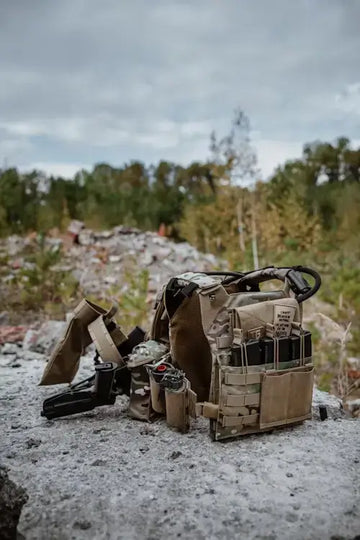How to Customize Your Tactical Cap for Maximum Efficiency
بواسطة Qingyun Qiu على May 28, 2024

Customizing your tactical cap can transform it from a standard piece of gear into a highly functional and personalized tool. Whether you need it for identification, utility, or simply style, there are many ways to modify your tactical cap.
Here's a step-by-step guide on adding patches, attachments, and other modifications to maximize efficiency.
Step 1: Choose the Right Cap
Before you start customizing, make sure you have a cap that supports modifications. Tactical caps with hook-and-loop panels are ideal because they allow for easy attachment of patches and accessories.
Also, look for caps made from durable materials like ripstop cotton or polyester, which can withstand harsh conditions and frequent use.
Step 2: Gather Your Materials
To customize your cap, you will need:
- Patches (morale patches, identification patches, or unit patches)
- Hook-and-loop tape (if your cap doesn’t already have panels)
- Sewing kit or fabric glue (for permanent attachments)
- Small carabiners or clips
- Elastic bands or paracord
- Small pouches or holders
Step 3: Attach Hook-and-Loop Panels
If your cap doesn’t already have hook-and-loop panels, you can add them yourself.
- Measure and Cut: Measure the area where you want to place the panels. Cut the hook-and-loop tape to size.
- Attach: Sew the panels onto the cap using a strong thread. If you prefer not to sew, use a strong fabric glue, but keep in mind that sewing provides a more durable hold.
Step 4: Add Patches
Patches are a simple way to customize your cap.
- Select Patches: Choose patches that serve your purpose. Morale patches for fun, identification patches for utility, or unit patches for affiliation.
- Attach: Simply press the hook side of the patch onto the loop panel on your cap. You can easily change or reposition patches as needed.

Step 5: Add Small Attachments
Adding small attachments can increase the functionality of your cap.
- Carabiners and Clips: Attach small carabiners or clips to the back strap of your cap. These can hold lightweight items like keys or a small flashlight.
- Elastic Bands or Paracord: Weave an elastic band or paracord through the loop panels or the back strap. This can hold items like a pen or a small multi-tool.
Step 6: Attach Small Pouches or Holders
If you need more storage, consider adding small pouches.
- Select a Pouch: Choose a lightweight, small pouch that won’t weigh down your cap.
- Attach: Use hook-and-loop strips or clips to attach the pouch to the back or side of your cap. Make sure it’s secure and doesn’t interfere with the fit.
Step 7: Test Your Customizations
Once you have added all your modifications, it's important to test them.
- Wear the Cap: Put on your cap and ensure that all attachments are secure and comfortable.
- Field Test: Try wearing the cap in different scenarios to see how it holds up. Make adjustments as necessary to improve comfort and functionality.

Customization Examples for Different Situations
Hiking and Camping
For outdoor activities, you might need to carry small survival items.
Patches: Add a reflective patch for visibility.
Attachments: Clip a small flashlight and a compass to the back strap.
Pouch: Attach a small waterproof pouch to hold matches or a fire starter.
Range Use
When spending time at the shooting range, customization can keep you organized.
Patches: Use a name patch for easy identification.
Attachments: Clip a pair of earplugs to the cap for quick access.
Pouch: Attach a small pouch to store spare batteries for your ear protection or red dot sight.
Everyday Carry (EDC)
For daily use, your cap can hold essential items.
Patches: Add a favorite morale patch for personal expression.
Attachments: Clip a pen and a small multi-tool to the back strap.
Pouch: Attach a small pouch to keep cash or a mini first aid kit.
Tactical Operations
For tactical missions, efficiency and readiness are crucial.
Patches: Use unit patches and infrared (IR) reflective patches for identification.
Attachments: Clip a small flashlight and a mini chem light for illumination.
Pouch: Attach a small medical pouch to hold band-aids and antiseptic wipes.
Tips for Effective Customization
- Balance Weight: Ensure that your attachments do not make the cap too heavy or unbalanced. Distribute weight evenly to maintain comfort.
- Accessibility: Place frequently used items where you can easily reach them. This is especially important in tactical or emergency situations.
- Durability: Make sure all attachments are securely fastened and can withstand vigorous activities.
- Aesthetics: While functionality is key, a neat and organized look can also be beneficial, especially in professional settings.
Conclusion
In short, customizing your tactical cap can greatly enhance its functionality and make it uniquely yours. By following these steps and tailoring your modifications to your unique needs, you'll have a cap that’s ready for any situation.
From adding patches for identification to attaching pouches for extra storage, there are countless ways to make your tactical cap more efficient. Equip yourself with the right gear, and you'll be prepared for anything that comes your way.





